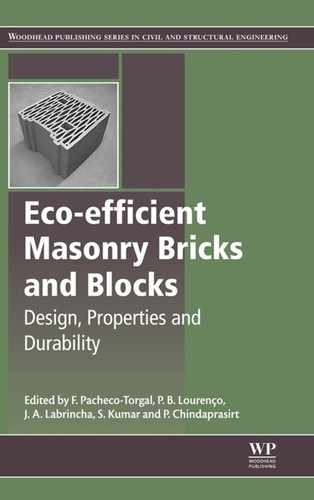Influence of large and highly perforated fired-clay bricks in the improvement of the equivalent thermal transmittance of single-leaf masonry walls
Abstract
This work presents a study about the factors influencing heat transfer in single-leaf walls made of large and highly perforated fired-clay brick, the aim being to reduce energy losses and moderate the use of heating and air conditioning. Those factors are the geometry of the brick (internal voids and vertical joints), the execution of the wall (horizontal joint) and the fired-clay thermal conductivity. This study provides a comprehensive analysis of the various factors by making a comparative study of the equivalent thermal transmittance of the wall obtained with different geometries and different executions of the wall, depending on thermal conductivity of clay. Note that this parameter is the one on which it is easiest to act by adding appropriate amounts of pore-forming additive in the manufacturing process. The results reveal that a percentage decrease in thermal conductivity of clay produces a linear percentage reduction in the thermal transmittance of the wall, regardless of the type of brick and wall mounting. In particular, a 50% decrease in the thermal conductivity of the clay leads to a 20% reduction in the equivalent thermal transmittance of the wall. An equation has been obtained that enables the calculation of the decrease in the equivalent thermal transmittance of a wall when the fired-clay thermal conductivity is decreased, with an estimate error of less than 3%.
Keywords
Energy efficiency; Large and highly perforated fired-clay brick; Single-leaf walls; Thermal conductivity; Thermal transmittance3.1. Introduction
3.2. Materials and methods
3.2.1. Bricks to study
3.2.2. Horizontal joint in brickwork wall
3.2.3. Fired-clay thermal conductivity
3.2.4. Boundary conditions for solving by finite element method
3.2.5. Thermal calculations

![]()
![]()
![]()

![]()
3.3. Results
3.3.1. Equivalent transmittance of the wall made of bricks with rectangular voids (block a) and the three types of horizontal joint
Table 3.1
Table comparing equivalent thermal transmittance levels using bricks with rectangular voids depending on the type of horizontal joint
| Block a | Ueq (W/m2-K) | ||
| Fired clay | Joint with standard mortar λm = 1.3 (W/m-K) | Joint of bonding mortar λm = 0.83 (W/m-K) | |
| λ (W/m-K) | Full-bed joint | 30-mm furrowed-bed joint | Thin joint |
| 0.600 | 0.7783 | 0.6654 | 0.5425 |
| 0.550 | 0.7558 | 0.6454 | 0.5245 |
| 0.500 | 0.7322 | 0.6246 | 0.5059 |
| 0.450 | 0.7072 | 0.6027 | 0.4867 |
| 0.400 | 0.6806 | 0.5797 | 0.4666 |
| 0.350 | 0.6521 | 0.5551 | 0.4456 |
| 0.300 | 0.6211 | 0.5286 | 0.4232 |

3.3.2. Equivalent transmittance of the wall made of bricks with rhomboidal voids (block b) and the three types of horizontal joint


Table 3.2
Table comparing equivalent thermal transmittance levels using bricks with rhomboidal voids, depending on the type of horizontal joint
| Block b | Ueq (W/m2-K) | ||
| Fired clay | Joint with standard mortar λm = 1.3 (W/m-K) | Joint of bonding mortar λm = 0.83 (W/m-K) | |
| λ (W/m-K) | Full-bed joint | 30-mm furrowed-bed joint | Thin joint |
| 0.600 | 0.6782 | 0.5594 | 0.4344 |
| 0.550 | 0.6595 | 0.5446 | 0.4226 |
| 0.500 | 0.6399 | 0.5291 | 0.4103 |
| 0.450 | 0.6192 | 0.5127 | 0.3976 |
| 0.400 | 0.5972 | 0.4954 | 0.3843 |
| 0.350 | 0.5735 | 0.4767 | 0.3700 |
| 0.300 | 0.5478 | 0.4564 | 0.3546 |

3.4. Comparative analysis
![]()
Table 3.3
Percentage improvement in the equivalent thermal transmittance of the wall according to the decrease in fired-clay thermal conductivity for bricks with rectangular voids
| Decrease λclay (%) | % Improvement in Ueq for “block a” | ||
| Joint with standard mortar λm = 1.3 (W/m-K) | Joint of bonding mortar λm = 0.83 (W/m-K) | ||
| Full-bed joint | 30-mm furrowed-bed joint | Thin joint | |
| 8.33% | 2.89% | 3.01% | 3.32% |
| 16.67% | 5.92% | 6.14% | 6.75% |
| 25.00% | 9.13% | 9.42% | 10.29% |
| 33.33% | 12.55% | 12.88% | 13.98% |
| 41.67% | 16.22% | 16.58% | 17.86% |
| 50.00% | 20.20% | 20.56% | 21.99% |

Table 3.4
Percentage improvement in the equivalent thermal transmittance of the wall according to the decrease in fired-clay thermal conductivity for bricks with rhomboidal voids
| Decreased λclay (%) | % Improvement in Ueq for “block b” | ||
| Joint with standard mortar λm = 1.3 (W/m-K) | Joint of bonding mortar λm = 0.83 (W/m-K) | ||
| Full-bed joint | 30-mm furrowed-bed joint | Thin joint | |
| 8.33% | 2.75% | 2.65% | 2.72% |
| 16.67% | 5.64% | 5.43% | 5.53% |
| 25.00% | 8.69% | 8.35% | 8.46% |
| 33.33% | 11.94% | 11.45% | 11.54% |
| 41.67% | 15.43% | 14.78% | 14.81% |
| 50.00% | 19.22% | 18.42% | 18.36% |








